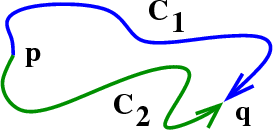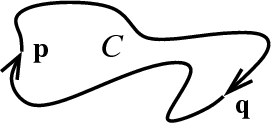A conservative vector field has no circulation
If the vector field $\dlvf$ is a conservative vector field (also called a path-independent vector field), then the line integral \begin{align*} \dlint \end{align*} does not depend on the actual path that $\dlc$ takes; the integral depends only on the beginning point (call it $\vc{p}$) and end point (call it $\vc{q}$) of the curve $\dlc$.
Suppose, for example, we have two curves $\dlc_1$ and $\dlc_2$ connecting point $\vc{p}$ with point $\vc{q}$.
Then we know that \begin{align*} \lint{\dlc_1}{\dlvf} =\lint{\dlc_2}{\dlvf} \label{eq:pathind} \end{align*} because $\dlvf$ is conservative.
Now, what would happen is we turned the path $\dlc_2$ around, so that it starts at point $\vc{q}$ and ends at point $\vc{p}$? (We will denote this curve with the opposite orientation as $\dlc_2^-$.) At any point, the tangent vector of $\dlc_2^-$ will be the opposite of the tangent vector of $\dlc_2$ because the path is going in the opposite direction. Consequently \begin{align*} \lint{\dlc_2^-}{\dlvf} = -\lint{\dlc_2}{\dlvf}. \label{eq:opposite} \end{align*}
If we define the curve $\dlc$ to be the curve $\dlc_1$ followed by the curve $\dlc_2^-$, the path of $\dlc$ will start at the point $\vc{p}$, go to the point $\vc{q}$ (via $\dlc_1$) and then return to the point $\vc{p}$ (via $\dlc_2^-$). In other words, the $\dlc$ will be a closed curve.
The line integral over $\dlc$ is simply the line integral over $\dlc_1$ plus the line integral over $\dlc_2^-$. By combining the above two equations, we see these these integrals are opposites \begin{align*} \lint{\dlc_2^-}{\dlvf} = -\lint{\dlc_1}{\dlvf}. \end{align*} We conclude that the line integral over $\dlc$ is zero: \begin{align*} \dlint = \lint{\dlc_1}{\dlvf} + \lint{\dlc_2^-}{\dlvf} =0. \end{align*}
If $\dlc$ is a closed curve, we call the integral \begin{align*} \dlint \end{align*} the circulation of $\dlvf$ around $\dlc$. If $\dlvf$ represents fluid flow, this integral indicates the tendancy for the fluid to circulate around the curve $\dlc$. We could use the above argument to show that $\dlvf$ is conservative if and only if the circulation around any closed curve is zero.
We can use this result as a test for path-dependence. If we can find a single closed curve $\dlc$ where \begin{align*} \dlint \ne 0, \end{align*} then we know that $\dlvf$ is path-dependent. For the example vector field $\dlvf(x,y) = (y, -x)$ shown at the end of the introduction to conservative fields, one can see the nonzero circulation around any circular path centered at the origin. This observation is enough to conclude that $\dlvf$ is path-dependent.
The key point to remember is that path-independence means there is no circulation around any closed curve.
Thread navigation
Multivariable calculus
- Previous: How to determine if a vector field is conservative
- Next: A path-dependent vector field with zero curl
Math 2374
Notation systems
Similar pages
- A path-dependent vector field with zero curl
- The gradient theorem for line integrals
- How to determine if a vector field is conservative
- Finding a potential function for conservative vector fields
- Finding a potential function for three-dimensional conservative vector fields
- A simple example of using the gradient theorem
- Testing if three-dimensional vector fields are conservative
- An introduction to conservative vector fields
- The idea of the curl of a vector field
- Subtleties about curl
- More similar pages

